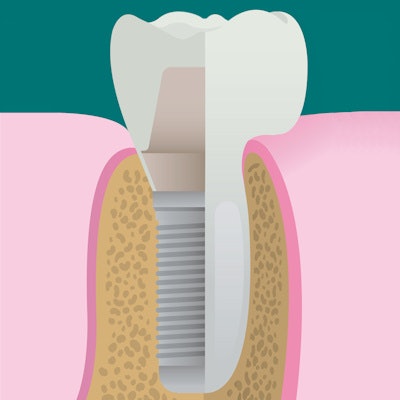
Threaded implants are thought to provide better primary stability and connection to bone than porous implants, but research to back that up is lacking. A new study examined the mechanical stability of the two types of implants.
Researchers measured implant stability and various mechanical properties of threaded and porous dental implants after placing them in both artificial bone blocks and edentulous cadaver mandibles. They found that the static and dynamic stiffness measurements of the porous implant system were greater than the threaded system when placed in human mandibular bone.
"These findings suggested that [the] trabecular-shaped architecture of the porous layer in porous implants may provide sufficient anchorage by increasing contacts between bone and implant," the study authors wrote (Clinical Biomechanics, August 5, 2017).
The lead author was Do-Gyoon Kim, PhD, an associate professor and the research program director at the Ohio State University College of Dentistry in Columbus.
Stable base
Implant design, bone quality and quantity surrounding the implant, and surgical technique are all believed to influence stability, which is a necessary component of an implant system's success. Excessive micromotion between bone and the implant surface, along with other factors, may contribute to implant failure by reducing primary stability and producing fibrous tissue at the bone-implant interface, according to the authors.
Threaded implants have been thought to theoretically provide a tighter interlock with surrounding bone that leads to greater primary stability than with porous implants. The researchers conducted the current study to compare the stability of the two implant systems using resonance frequency analysis, a noninvasive, reproducible method for estimating implant stability in patients.
They placed 42 threaded implants (Tapered Screw-Vent implant, 4.1-mm diameter x 10-mm length, Zimmer Biomet) and 42 highly porous dental implants (Trabecular Metal implant, 4.1-mm diameter x 10-mm length, Zimmer Biomet) into artificial polyurethane bone foam sheets with seven thicknesses ranging from 3.5 mm to 12 mm.
Both implants had a titanium alloy threaded portion, and the crestal region had a 0.5-mm machined collar and a 1.8-mm section of textured microgrooves 0.1-mm deep. The porous implant was constructed of three welded pieces: a microgrooved cervical section above 1.9 mm of threads, an unthreaded midsection of highly porous tantalum material, and a threaded apical section.
Additionally, the researchers implanted 11 threaded and 11 porous implants in eight edentulous mandibles without evidence of bone disease obtained from human cadavers. Four implants were placed in seven mandibles, with a pair of the two types in each. A contralateral pair of one threaded and one porous implant was placed in the eighth mandible.
The researchers measured peak insertion torque during implantation of all implants and also assessed implant stability quotient values. They measured static stiffness of the implant systems in artificial bone blocks on the holding jig and human mandibles after they were dissected for implant stability quotient measurement.
Implant stability
The researchers found that the porous implants had significantly lower implant stability quotient values and insertion torque values than the threaded implants for artificial bone thicknesses of 5.5 mm or greater. However, the values were not significantly different for 8.5-mm thickness.
“The trabecular-shaped architecture of the porous layer in porous implants may provide sufficient anchorage by increasing contacts between bone and implant.”
Static and dynamic stiffness measures were not significantly different between the two implant groups at various thicknesses except for static stiffness at 3.5 mm and dynamic stiffness at 5.5 mm, which were significantly higher for the threaded implant group than the porous group.
"The higher axial static and dynamic stiffness of the porous implant group than those of the threaded implant group in the human cadaveric mandible would also suggest that contacts of the porous material with bone could bear axial loading better than lateral and shear loading," the authors wrote.
They noted that this study allowed for the isolation of the effects of differences between the implant systems, including the highly porous tantalum layer compared with the tapered and threaded design, on primary stability in conjunction with varying artificial bone block thicknesses. The significantly higher static stiffness of the threaded implants at 3.5-mm thickness demonstrated that the tapered thread of this implant helped to improve its axial static stability, according to the authors.
"Higher contacts between the porous layer and bone surface likely increase the insertion torque, while the static and dynamic stiffness of the porous implant system increased more than those of the threaded implant system," they wrote.
Implantation healing
A limitation of this study was that it only measured primary stability immediately after implantation and not changes that occur during postimplantation healing, the authors noted. Additionally, they did not measure bone-implant contact. New technology is needed to perform the necessary measurement of 3D geometry and stability at the implant interface, they wrote.
Nevertheless, their current research allowed for some important conclusions.
"The porous layer supports axial loading better than lateral and shear loading of the dental implant system," the authors concluded. "This result indicates that trabecular-shaped architecture of the porous layer may provide sufficient anchorage compromising reduction of the axial primary stability of the porous implant system to be comparable with the threaded implant system."



















